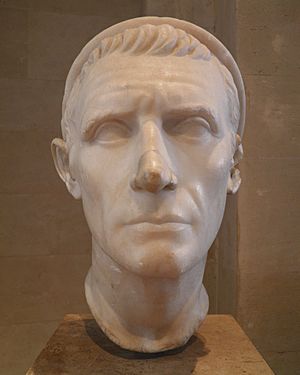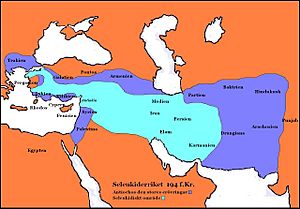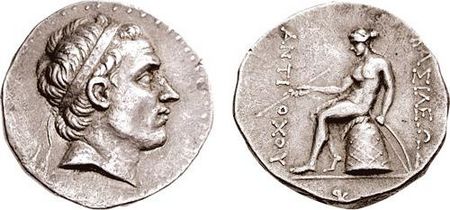Antiochus III the Great facts for kids
Quick facts for kids Antiochus III |
|||||
|---|---|---|---|---|---|
| Basileus Megas | |||||

Bust from the Louvre, possibly Roman copy of Hellenistic portrait of Antiochus III
|
|||||
| Basileus Megas of the Seleucid Empire | |||||
| Reign | April/June 222 – 3 July 187 BC (36 years) |
||||
| Predecessor | Seleucus III Ceraunus | ||||
| Successor | Seleucus IV Philopator | ||||
| Born | c. 241 BC Susa, Seleucid Empire |
||||
| Died | 3 July 187 BC (aged 54) Susa, Seleucid Empire |
||||
| Spouse | Laodice III Euboea of Chalcis |
||||
| Issue | Antiochus Seleucus IV Philopator Ardys Laodice of Bactria Laodice IV, Queen of the Seleucid Empire Cleopatra I Syra, Queen of Egypt Antiochis, Queen of Cappadocia Antiochus IV |
||||
|
|||||
| Dynasty | Seleucid | ||||
| Father | Seleucus II Callinicus | ||||
| Mother | Laodice II | ||||
| Religion | Greek polytheism | ||||
Antiochus III the Great (born around 241 BC, died 3 July 187 BC) was a powerful Greek king. He ruled the Seleucid Empire from 222 to 187 BC. This empire covered much of Syria and other parts of western Asia.
Antiochus became king when he was just eighteen. At first, his wars against the Ptolemaic Kingdom (another Greek kingdom in Egypt) didn't go well. But later, he won many battles and made his empire much bigger. He was called "the Great" because of his military successes. He also used the title Basileus Megas, which means "Great King." This was a traditional title used by Persian kings before him.
Antiochus was a very active ruler. He brought back much of the land that the Seleucid Empire had lost. However, he faced a big challenge at the end of his rule. He fought a war against the powerful Roman Republic. He said he was fighting for "Greek freedom against Roman rule." This war lasted four years, starting in Greece in 192 BC. Antiochus was finally defeated in a major battle called the Battle of Magnesia. He died three years later while on a military trip in the east.
Contents
Biography of Antiochus III
Becoming King and Early Challenges
Antiochus III was part of the Seleucid dynasty, a family of Greek kings. His father was King Seleucus II Callinicus. His mother was Laodice II. Antiochus was born around 241 BC in Susa, a city in Persia. He became king after his brother, Seleucus III Ceraunus, was killed. Antiochus was in Babylon at that time.
When Antiochus III became king, his empire was not well organized. Some areas, like Asia Minor, had broken away. Provinces in the east, like Bactria and Parthia, had also become independent. Soon after he took the throne, in 222 BC, two governors named Molon and Alexander rebelled. They controlled the regions of Media and Persis.
The young king listened to his minister, Hermeias. He decided to attack Ptolemaic Syria instead of dealing with the rebels himself. But this attack failed. The generals sent against Molon and Alexander also lost badly. Only in Asia Minor did the Seleucid power grow stronger. Antiochus's cousin, Achaeus, pushed back the kingdom of Pergamon.
In 221 BC, Antiochus finally went east himself. The rebellion by Molon and Alexander quickly ended. He also brought Lesser Media back under his control. Antiochus then had Hermeias killed and returned to Syria in 220 BC. Meanwhile, Achaeus in Asia Minor had declared himself king. But Achaeus wasn't strong enough to attack Syria. So, Antiochus decided to try taking Ptolemaic Syria again.
Wars Against Other Greek Rulers

Antiochus's armies marched deep into the Ptolemaic Kingdom in 219 BC and 218 BC. But in 217 BC, Ptolemy IV defeated Antiochus at the Battle of Raphia. This loss made Antiochus pull his armies back north of Lebanon.
In 216 BC, Antiochus went to western Anatolia. He wanted to stop the rebellion led by his cousin, Achaeus. By 214 BC, he had forced Achaeus into the city of Sardis. Antiochus captured Achaeus and had him executed. Achaeus's wife, Laodice, held out in the citadel until 213 BC before surrendering.
After getting back the central part of Asia Minor, Antiochus focused on the eastern and northern provinces. In 209 BC, he invaded Parthia. He captured its capital, Hecatompylos. He also won the Battle of Mount Labus. The Parthian king, Arsaces II, then asked for peace.
Campaigns in Bactria and India
In 209 BC, Antiochus went to Bactria. There, a new king named Euthydemus I had taken over. Antiochus won again, defeating Euthydemus at the Battle of the Arius. Euthydemus then faced a long siege in his capital, Bactra (modern Balkh). He eventually made an honorable peace with Antiochus. As part of the deal, Antiochus promised his daughter, Laodice, to Euthydemus's son, Demetrius.
Next, Antiochus followed in the footsteps of Alexander the Great. He crossed into the Kabul valley. He even reached the kingdom of an Indian king named Sophagasenus. He then returned west through Seistan and Kerman in 206/5 BC.
Campaigns in Persia and Coele Syria
After his eastern campaigns, Antiochus led a short trip down the Persian Gulf. He fought against the Gerrhaeans on the Arabian coast in 205/204 BC. Antiochus had successfully brought back much of the Seleucid Empire's lost territory in the east. This is why he earned the title "the Great."
Around 205/204 BC, a young child named Ptolemy V Epiphanes became the king of Egypt. Some historians say Antiochus made a secret deal with Philip V of Macedon. They planned to divide the lands belonging to the Ptolemaic Kingdom. Under this plan, Macedon would get Ptolemy's lands around the Aegean Sea. Antiochus would take Cyprus and Egypt.
Antiochus then attacked the Ptolemaic province of Coele Syria and Phoenicia again. By 199 BC, he seemed to control it. But an Aetolian leader named Scopas took it back for Ptolemy. This was only for a short time. In 198 BC, Antiochus defeated Scopas at the Battle of Panium. This battle was near the sources of the Jordan. It marked the end of Ptolemaic rule in Judea.
War Against Rome and Death
Antiochus then moved into Asia Minor, by land and sea. He wanted to secure the coastal towns that belonged to Ptolemy and the independent Greek cities. This made the Roman Republic angry. Cities like Smyrna and Lampsacus asked Rome for help. Rome saw itself as a protector of Greek freedom.
The tension grew when Antiochus gained a foothold in Thrace in 196 BC. When the Romans left Greece, Antiochus saw his chance. He even had the famous general Hannibal at his court, who encouraged him.
In 192 BC, Antiochus invaded Greece with 10,000 soldiers. He was chosen as the commander of the Aetolian League. However, in 191 BC, the Romans, led by Manius Acilius Glabrio, defeated him at Thermopylae. This forced Antiochus to retreat to Asia Minor.
The Romans followed him into Anatolia. A major victory by Scipio Asiaticus at Magnesia ad Sipylum in 190 BC sealed Antiochus's fate. Before this, Hannibal's fleet was also defeated at sea. These losses put Asia Minor into Roman hands.
By the Treaty of Apamea in 188 BC, Antiochus had to give up all his lands north and west of the Taurus. Rome gave most of this land to its allies, Rhodes or Eumenes II. Many Greek cities were allowed to be free. Because of this big loss, many distant parts of Antiochus's empire became independent again.
Antiochus went on a new trip to the east, to Luristan. He was killed in 187 BC while trying to take treasure from a temple of Bel in Elymais, Persia.
Family Life
In 222 BC, Antiochus III married Princess Laodice of Pontus. She was the daughter of King Mithridates II of Pontus. Antiochus and Laodice were first cousins. They had eight children together: three sons and five daughters.
Their children included:
- Antiochus (221–193 BC), his first son and heir.
- Seleucus IV Philopator (around 220–175 BC), who became king after Antiochus III.
- Ardys.
- An unnamed daughter, who was promised in marriage to Demetrius I of Bactria around 206 BC.
- Laodice IV, who married all three of her brothers at different times.
- Cleopatra I Syra (around 204–176 BC), who married Ptolemy V Epiphanes of Egypt in 193 BC.
- Antiochis, who married King Ariarathes IV of Cappadocia in 194 BC.
- Mithridates (215–164 BC), who became King Antiochus IV Epiphanes in 175 BC.
In 191 BC, Antiochus III married a woman from Chalcis. He named her "Euboea." They did not have any children. Laodice III, his first wife, lived longer than Antiochus III. She was seen in Susa in 183 BC.
Antiochus and the Jewish People
Antiochus III moved 2,000 Jewish families from Babylonia to the regions of Lydia and Phrygia in Anatolia. The historian Josephus wrote that Antiochus was friendly towards the Jewish people in Jerusalem. He knew they were loyal to him. This was very different from how his son would treat them later. Antiochus III actually lowered taxes for them. He also gave money to the Temple and let the Jewish people live "according to the law of their forefathers."
Mention in the Books of Maccabees
Antiochus III is mentioned in the Books of the Maccabees. These books tell the story of the Maccabean Revolt against Antiochus's son, Antiochus IV Epiphanes.
Antiochus III is first mentioned in 1 Maccabees 1:10. Here, Antiochus IV is introduced as "son of King Antiochus [Antiochus III]."
He is mentioned again in 1 Maccabees 8. This part describes how Judas Maccabeus knew about the actions of the Roman Republic. It mentions how the Romans defeated Antiochus III. The text says: "They [the Romans] also had defeated Antiochus the Great, king of Asia, who went to fight against them with one hundred twenty elephants and with cavalry and chariots and a very large army. He was crushed by them; they took him alive and decreed that he and those who would reign after him should pay a heavy tribute and give hostages and surrender some of their best provinces, the countries of India, Media, and Lydia. These they took from him and gave to King Eumenes." (1 Maccabees 8:6-8)
Cultural References
- A play from the 1600s, Believe as You List, is about Antiochus's fight against the Romans after the Battle of Thermopylae.
- Antiochus also appears near the end of Norman Barrow's historical novel, The High Priest (1947). This is after his armies took Jerusalem back from the Ptolemaic forces.
See also
 In Spanish: Antíoco III el Grande para niños
In Spanish: Antíoco III el Grande para niños
- List of Syrian monarchs
- Timeline of Syrian history



